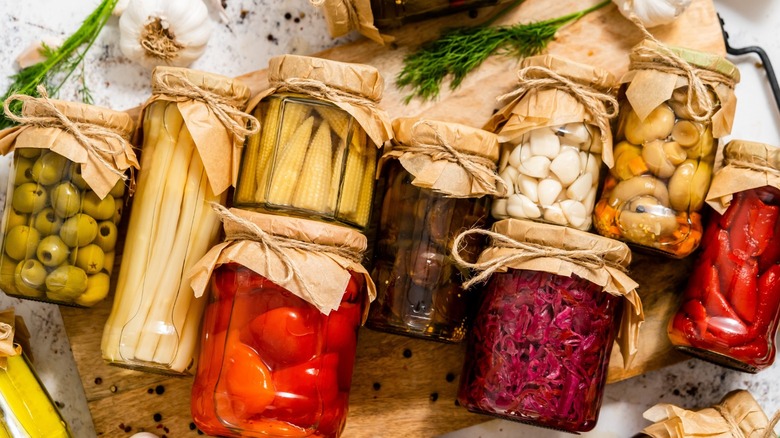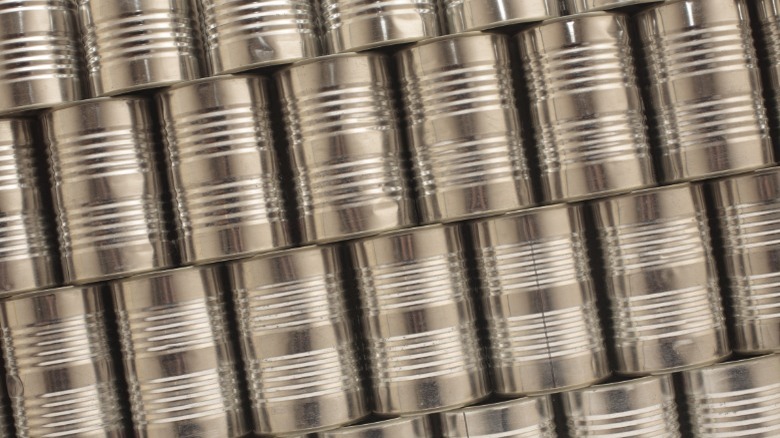How Lacto-Fermentation Is Different From Canning
The science behind food preservation is intriguing — even if you're not just trying to prepare for the apocalypse by pickling all of your veggies. There are many different ways that everyday staples can be made to last longer in your cabinet, but there are distinct differences between the methods and which foods will work best with them. The mode of preservation you choose depends on what kind of result you're ultimately looking for.
Lacto-fermentation and canning are two very different methods of food preparation but can be easily confused because the results and tactics may often look similar. Both have been used for hundreds of years and across cultural boundary lines, so what's the real difference between lacto-fermentation and canning? In reality, they're two very distinct processes that produce very different results. You can apply both the processes of lacto-fermentation and canning to cucumbers, for example, but each end product is going to be unique.
What is lacto-fermentation and how does it work?
Lacto-fermentation is a specific type of fermentation and, as the name may imply, makes use of bacteria that produce lactic acid to aid in food preservation. Lactic acid is created when sugar is broken down in environments that are lacking oxygen. The lactic acid-producing bacteria can be found in nature, but can also be added in order to begin the fermentation process.
So, how can you lacto-ferment something? According to Healthline, the easiest way to do so is to find a food that already has lactic acid bacteria and put it in a mixture of water and salt. Generally, you'd recognize the most common lacto-fermented foods — this list includes items like cabbage, garlic, carrots, and cucumbers that get transformed into delicious salty pickles. Besides pickles, kimchi and sauerkraut are also the result of lacto-fermentation. All you really need to do lacto-fermentation yourself is the right veggies and an airtight container (like a mason jar) in order to limit oxygen exposure. It can take as little as a few days all the way up to a few months for lacto-fermentation to occur, but the months are worth it if the result is the satisfying crunch of a pickle.
So why is canning different?
Now onto canning, and how it's different from lacto-fermentation. Canning has roots in Napoleonic France but has also been embraced here in the States. Like lacto-fermentation, canning is meant to preserve food, but the major difference between the two is that canning utilizes heat. The high levels of heat used in the canning process are meant to kill any harmful bacteria or microorganisms that may exist in the food being preserved. By ridding the food of these organisms, canning allows fruits and veggies that may normally only last a few days to have a significantly extended shelf life. Most foods can be canned in some way or another, but the common ones you may recognize are fruits and jellies, tomatoes, vegetables, and salsas.
So what are the benefits of canning versus other methods of food preservation? For one, canned food lasts much longer than fermented foods — no, that jar of pickles in the back of your fridge doesn't last forever. In addition, canned foods retain their flavor and are normally softer or cooked, whereas fermented foods gain new flavors. Canned foods are also able to be stored with a little more flexibility, while fermented items have to be kept in the fridge or in cool temperatures. In comparison, lacto-fermented foods retain a lot of their nutrients and have additional health benefits, like kimchi's anti-inflammatory effects. Lacto-fermentation could be more beneficial than canning health-wise, but the process you choose really just depends on your end goal for flavor or storage.


